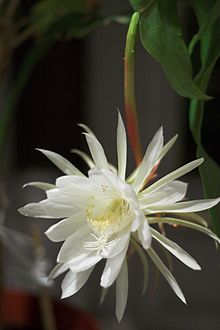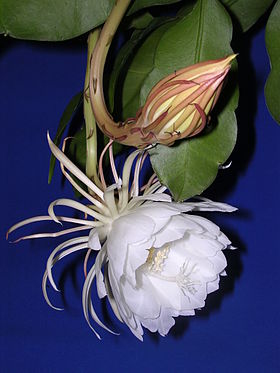- Epiphyllum oxypetalum
-
Epiphyllum oxypetalum 
Flower of Epiphyllum oxypetalum Scientific classification Kingdom: Plantae (unranked): Angiosperms (unranked): Eudicots (unranked): Core eudicots Order: Caryophyllales Family: Cactaceae Genus: Epiphyllum Species: E. oxypetalum Binomial name Epiphyllum oxypetalum
(de Candolle) HaworthEpiphyllum oxypetalum (Dutchman's Pipe, kardable, Night Queen or निशागंधी Nishagandhi or Gul-e-Bakawali) is a species of cactus and one of the most cultivated species in the genus. It is a variety of nightblooming Cereus and often confused with species of Selenicereus.
Contents
Synonymy
- Cereus oxypetalus Moc. & Sesse ex de Candolle (1828) Prodr. 3:470
- Epiphyllum oxypetalum (de Candolle) Haworth (1829) Phil. Mag. 6:109
- Cereus latifrons Pfeiffer (1838) Enom. cact. 125
- Phyllocactus oxypetalus (de Candolle) Link ex Walpers (1843) Repert. Bot. 2:341
- Phyllocactus latifrons (Pfeiffer) Link ex Walpers (1843) Repert. Bot. 2:341
- Phyllocactus grandis Lemaire (1847) Fl. Serr. 3:225. b.
- Phyllocactus guyanensis Brongnart ex Labouret (1853) Monogr. Cact. 416
- Epiphyllum acuminatum K. Schumann in Martius (1890) Fl. Bras. 4:222
- Phyllocactus acuminatus (K. Schumann) K. Schumann (1897) Gesamtb. Kakt. 213
- Phyllocactus purpursii Weingart (1907) Moatsschr. Kakteenk. 17:34
- Epiphyllum grande (Lemaire) Britton & Rose (1913) Contr. U. S. Nat. Herb. 16:257
- Epiphyllum oxypetalum v. purpusii (Weingart) Backeberg (1952) Die Cactac. 2:747
Etymology
Oxypetalum (Lat.) = with acute petals, refers to the acute petals of this species.
History
Native to Sri Lanka[citation needed], the Kadupul flower blooms rarely and only at night – mysteriously, the flower wilts before dawn. In 1909, C. A. Purpus collected a slightly different type in St. Ana, Orizaba, Mexico. It has carmine red outer petals and the flowers have an unpleasant smell, rather than being fragrant. It was originally named Phyllocactus purpusii, but does probably not deserve any botanical recognition. The Chinese chengyu (four character idiom) 曇花一現 (tan hua yi xian) uses this flower (tan-hua; 曇花) to describe someone who has an impressive but very brief moment of glory, like a "flash in a pan", since the flower can take a year to bloom and only blooms over a single night. Therefore someone described as "曇花一現" is generally understood to be a person who shows off or unexpectedly gains some achievement and is thought to be an exception or only lucky. The flower also has a rich history in Japan, where it is known as the 月下美人 (Gekka Bijin) or "Beauty under the Moon".
Origin and habitat
It can be found from Mexico to Venezuela, as well as Brazil. It also can be found, cultivated in parts of America with warmer temperature such as California. Epiphytic or lithophytic. 75-2.000 m alt. Widely cultivated and escaped in many places and its true origin has never been fully understood. Linked to the Legend of "BAKAWALI" in most S.E. Asian countries.
Systematics
This species is closely related to E. thomasianum and E. pumilum, but quite distinct.
Cultivation
An easily cultivated, fast growing epiphyte. It needs compost containing plenty of humus and sufficient moisture in summer. It should not be kept under 10°C (50°F) in winter. It can be grown in semi-shade or full sun. Extra light in the early spring will stimulate budding. It flowers in late spring or early summer; large specimens can produce several crops of flowers in a season. This is the most commonly grown of the Epiphyllum species, and it is known under several common names including Night-blooming Cereus, Dutchman's Pipe, Queen of the Night, Wijaya Kusuma (Indonesian), निषागंधी (Nishagandhi in Hindi and Marathi), Gul-e-Bakavali (in Urdu) and කඩුපුල් (Kadupul in Sinhala).
Description
Stems erect, ascending, scandent or sprawling, profusely branched, primary stems terete, to 2–6 m long, flattened laterally, ligneous at base, secondary stems flat, elliptic-acuminate, to 30 cm x 10–12 cm, thin; margins shallowly to deeply crenate and ± undulate. Flowers produced from flattened portions, to 30 cm long, 12–17 cm wide, nocturnal, very fragrant. The principal odor component in the aroma is benzyl salicylate; pericarpel nude, slightly angled, green, bracteoles short; receptacle 13–20 cm long, 1 cm thick, brownish, arching, bracteoles narrow, ca 10 mm long; outer tepals linear, acute, 8–10 cm long reddish to amber; inner tepals oblanceolate to oblong, acuminate, to 8–10 cm long and 2,5 cm wide, whitish; stamens greenish white or white, slender and weak; style greenish white or white, 4 mm thick, as long as inner tepals, lobes many, pale yellow or white. Fruit oblong, 12 x 8 cm, purplish red, angled.
Source
The article was originally written for the site:[1]
References
- Anderson, E. F. 2001. The cactus family. Timber Press, Portland, Oregon, USA.
External links
Categories:- Night-blooming plants
- Cacti
- Cacti of Mexico
- Epiphytes
Wikimedia Foundation. 2010.




